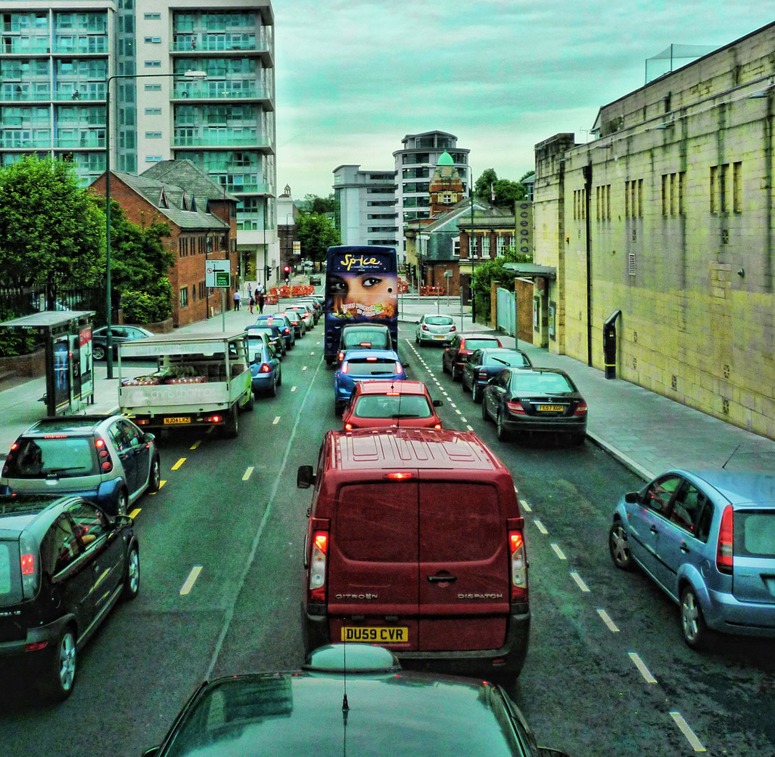 Whodunnit? A wordsmith writes of ‘Poor torn-up Nottingham, with its smell of saturated fats and the ubiquitous roar of passing cars circling its city centre like Apaches in a cowboy movie’. But who did it? And what can be done about it? The Sunday Times art critic (Waldemar Januszczak, 31.10.10) also says this mess is ‘fully representative of Britain today’. Should we blame the town council? the city engineers? the planners? the architects? central government? immigrants? the landscape architects? All of them? Diagnosis comes before treatment, so the question needs to be answered. Could an Oberbaudirektor have prevented the mess? Or would he have contributed to the stench of saturated fat?
Whodunnit? A wordsmith writes of ‘Poor torn-up Nottingham, with its smell of saturated fats and the ubiquitous roar of passing cars circling its city centre like Apaches in a cowboy movie’. But who did it? And what can be done about it? The Sunday Times art critic (Waldemar Januszczak, 31.10.10) also says this mess is ‘fully representative of Britain today’. Should we blame the town council? the city engineers? the planners? the architects? central government? immigrants? the landscape architects? All of them? Diagnosis comes before treatment, so the question needs to be answered. Could an Oberbaudirektor have prevented the mess? Or would he have contributed to the stench of saturated fat?
Image courtesy Maddy Lou

It is not all bad…[ http://www.acrossthebritain.co.uk/wp-content/uploads/2009/09/view-from-castle.jpg ]
There is incredible potential in the marketplace.
[ http://freepages.genealogy.rootsweb.ancestry.com/~leveritt/42_11_Nottingham_Market_Place_1900.jpg ] and elsewhere [ http://www.nutritionsociety.org/development/files/uploads/Nottingham.jpg ]
Also
[ http://www.infobritain.co.uk/Nottingham_Castle_Gate.jpg ]
It is just a matter of putting it all together.
Oh no, its not all bad. And there many worse cities in the UK and elsewhere. But what they should have done is read the Buchanan Report and acted upon it, as so many German cities did. When I think about the different fates of Germany and Britain since 1945, the words which most often come to mind are from Aleksandr Isayevich Solzhenitsyn: ‘victories are good for governments and defeats are good for the people’. In other words: I blame the political system rather than the professions, though I also blame the professions for ‘going along’ with the politicians instead of hold out for their beliefs.
And again on the other hand, walking around Nottingham’s town centre, much of it pedestrianised, on a winter’s night last year and despite the dire headlines, I felt perfectly safe and happily part of the passing crowd in the pre-Christmas market. Same again on a return this summer, when the redesigned, but essentially 18th-century space (see views by Sandby) still functions as such, though with the useful addition of a tram and cabs.
Also good parks and allotments, and lots of trees.
I am sure most UK cities could have similar photos as your illustration; presumably showing two lines of traffic and a row of parked cars (on the right) on a former industrial route? It’s certainly true we have made a mess of many of our cities, demolishing good old buildings and replacing them with shoddy new stuff, but was ever thus.
The aspect of the photograph which surprises me is the architectural jumble. I quite like the trees, the red brick and the bluish glass on the left side of the photograph but did the planners like it too, or did they decide that architectural design has nothing to do with town and country planning? I think they should have protected pedestrians from traffic fumes and, if the footpath gets as little use as in the photograph then they should use part of the width for a cycle path. And why not have some trees on the right side of the street?